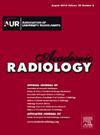A Deep Learning Model for Predicting Molecular Subtype of Breast Cancer by Fusing Multiple Sequences of DCE-MRI From Two Institutes
IF 3.8
2区 医学
Q1 RADIOLOGY, NUCLEAR MEDICINE & MEDICAL IMAGING
引用次数: 0
Abstract
Rationale and Objectives
To evaluate the performance of deep learning (DL) in predicting different breast cancer molecular subtypes using DCE-MRI from two institutes.
Materials and Methods
This retrospective study included 366 breast cancer patients from two institutes, divided into training (n = 292), validation (n = 49) and testing (n = 25) sets. We first transformed the public DCE-MRI appearance to ours to alleviate small-data-size and class-imbalance issues. Second, we developed a multi-branch convolutional-neural-network (MBCNN) to perform molecular subtype prediction. Third, we assessed the MBCNN with different regions of interest (ROIs) and fusion strategies, and compared it to previous DL models. Area under the curve (AUC) and accuracy (ACC) were used to assess different models. Delong-test was used for the comparison of different groups.
Results
MBCNN achieved the optimal performance under intermediate fusion and ROI size of 80 pixels with appearance transformation. It outperformed CNN and convolutional long-short-term-memory (CLSTM) in predicting luminal B, HER2-enriched and TN subtypes, but without demonstrating statistical significance except against CNN in TN subtypes, with testing AUCs of 0.8182 vs. [0.7208, 0.7922] ( = 0.44, 0.80), 0.8500 vs. [0.7300, 0.8200] ( = 0.36, 0.70) and 0.8900 vs. [0.7600, 0.8300] ( = 0.03, 0.63), respectively. When predicting luminal A, MBCNN outperformed CNN with AUCs of 0.8571 vs. 0.7619 ( = 0.08) without achieving statistical significance, and is comparable to CLSTM. For four-subtype prediction, MBCNN achieved an ACC of 0.64, better than CNN and CLSTM models with ACCs of 0.48 and 0.52, respectively.
Conclusion
Developed DL model with the feature extraction and fusion of DCE-MRI from two institutes enabled preoperative prediction of breast cancer molecular subtypes with high diagnostic performance.
通过融合两家研究所的多序列 DCE-MRI 预测乳腺癌分子亚型的深度学习模型。
材料与方法这项回顾性研究纳入了来自两家研究所的 366 名乳腺癌患者,分为训练集(n = 292)、验证集(n = 49)和测试集(n = 25)。我们首先将公开的 DCE-MRI 图像转换成我们的图像,以缓解数据量小和类别不平衡的问题。其次,我们开发了多分支卷积神经网络(MBCNN)来进行分子亚型预测。第三,我们用不同的兴趣区域(ROI)和融合策略对 MBCNN 进行了评估,并将其与之前的 DL 模型进行了比较。曲线下面积(AUC)和准确率(ACC)用于评估不同的模型。结果 在中间融合和 ROI 大小为 80 像素的情况下,MBCNN 通过外观变换获得了最佳性能。它在预测管腔 B 型、HER2-富集型和 TN 亚型方面的表现优于 CNN 和卷积长短期记忆(CLSTM),但在 TN 亚型方面与 CNN 相比没有统计学意义,其测试 AUC 为 0.8182 vs. [0.7208, 0.7922] (p = 0.44, 0.80)、0.8500 vs. [0.7300, 0.8200] (p = 0.36, 0.70) 和 0.8900 vs. [0.7600, 0.8300] (p = 0.03, 0.63)。在预测管腔 A 时,MBCNN 的 AUC 值为 0.8571 vs. 0.7619(p = 0.08),优于 CNN,但未达到统计学显著性,与 CLSTM 相当。在四种亚型预测方面,MBCNN 的 ACC 为 0.64,优于 CNN 和 CLSTM 模型的 ACC(分别为 0.48 和 0.52)。
本文章由计算机程序翻译,如有差异,请以英文原文为准。
求助全文
约1分钟内获得全文
求助全文
来源期刊

Academic Radiology
医学-核医学
CiteScore
7.60
自引率
10.40%
发文量
432
审稿时长
18 days
期刊介绍:
Academic Radiology publishes original reports of clinical and laboratory investigations in diagnostic imaging, the diagnostic use of radioactive isotopes, computed tomography, positron emission tomography, magnetic resonance imaging, ultrasound, digital subtraction angiography, image-guided interventions and related techniques. It also includes brief technical reports describing original observations, techniques, and instrumental developments; state-of-the-art reports on clinical issues, new technology and other topics of current medical importance; meta-analyses; scientific studies and opinions on radiologic education; and letters to the Editor.
 求助内容:
求助内容: 应助结果提醒方式:
应助结果提醒方式:


